Coaching and Mentoring Within the Organisation: A Leadership Report
VerifiedAdded on 2022/08/28
|19
|5004
|23
Report
AI Summary
This report delves into the critical roles of coaching and mentoring within an organization, emphasizing their significance in employee development and organizational success. It begins by highlighting the necessity of adapting to the changing needs of a globalized workforce and the value of knowledgeable employees. The report introduces coaching and mentoring as essential training and development tools, focusing on how they enhance staff skills and knowledge. It examines the benefits, different models like the GROW and Five-Factor models, types of coaching and mentoring, and the relative merits of line managers as coaches and mentors. The report concludes with recommendations for effective implementation, aiming to guide the executive team in fostering a skilled and knowledgeable workforce through these practices. The report underscores the importance of ongoing training and development to meet the evolving demands of a complex business environment.
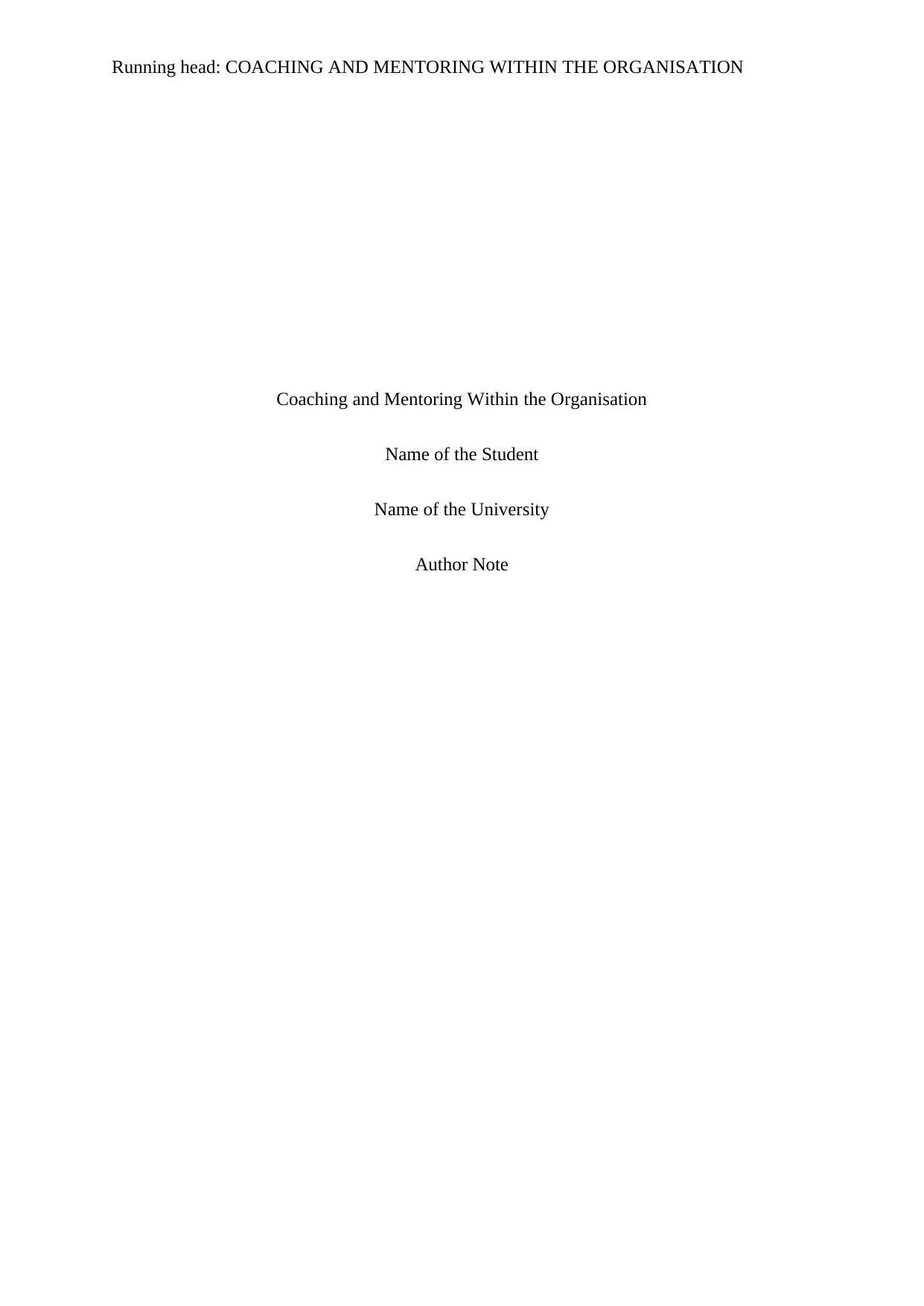
Running head: COACHING AND MENTORING WITHIN THE ORGANISATION
Coaching and Mentoring Within the Organisation
Name of the Student
Name of the University
Author Note
Coaching and Mentoring Within the Organisation
Name of the Student
Name of the University
Author Note
Paraphrase This Document
Need a fresh take? Get an instant paraphrase of this document with our AI Paraphraser
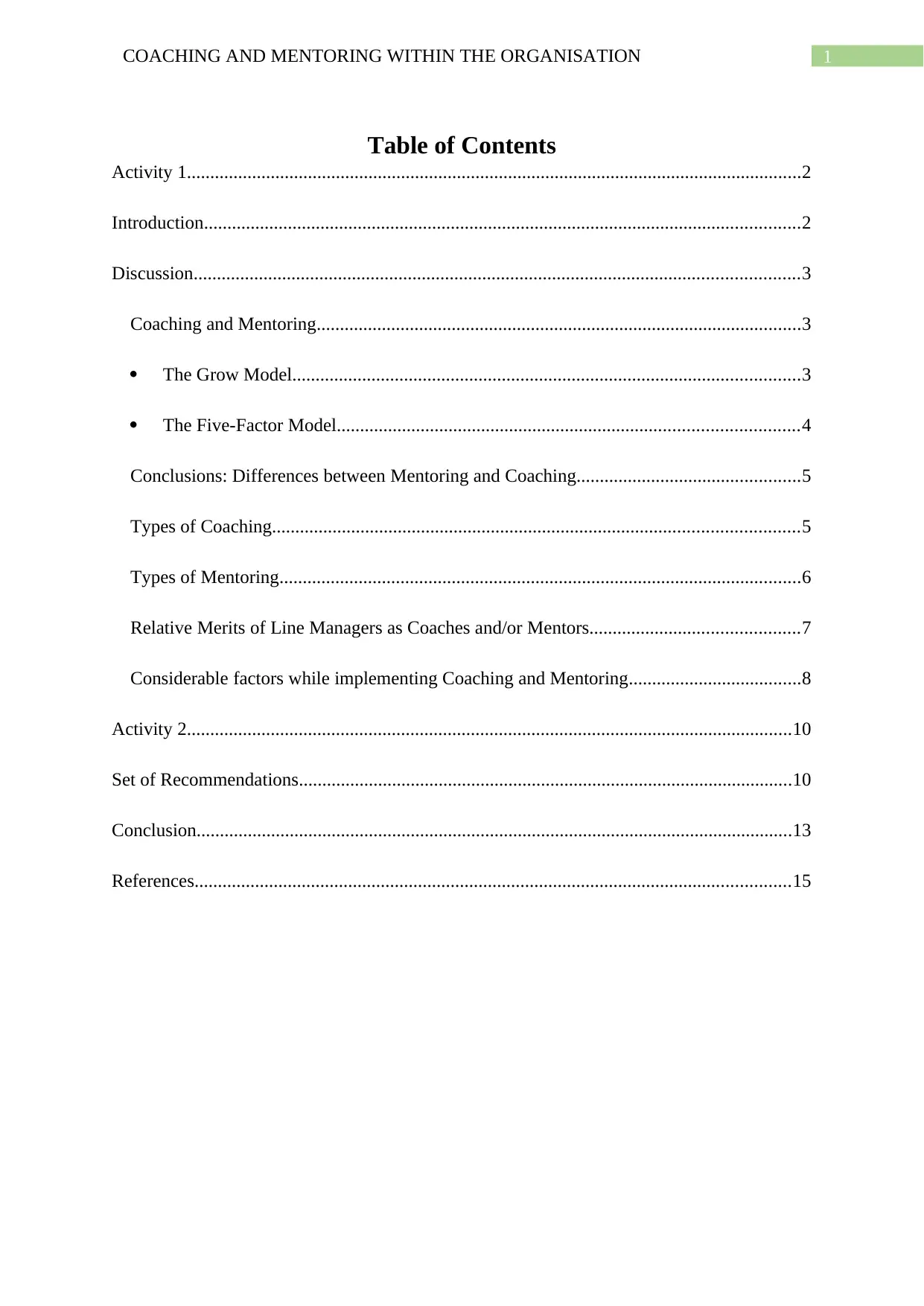
1COACHING AND MENTORING WITHIN THE ORGANISATION
Table of Contents
Activity 1....................................................................................................................................2
Introduction................................................................................................................................2
Discussion..................................................................................................................................3
Coaching and Mentoring........................................................................................................3
The Grow Model.............................................................................................................3
The Five-Factor Model...................................................................................................4
Conclusions: Differences between Mentoring and Coaching................................................5
Types of Coaching.................................................................................................................5
Types of Mentoring................................................................................................................6
Relative Merits of Line Managers as Coaches and/or Mentors.............................................7
Considerable factors while implementing Coaching and Mentoring.....................................8
Activity 2..................................................................................................................................10
Set of Recommendations..........................................................................................................10
Conclusion................................................................................................................................13
References................................................................................................................................15
Table of Contents
Activity 1....................................................................................................................................2
Introduction................................................................................................................................2
Discussion..................................................................................................................................3
Coaching and Mentoring........................................................................................................3
The Grow Model.............................................................................................................3
The Five-Factor Model...................................................................................................4
Conclusions: Differences between Mentoring and Coaching................................................5
Types of Coaching.................................................................................................................5
Types of Mentoring................................................................................................................6
Relative Merits of Line Managers as Coaches and/or Mentors.............................................7
Considerable factors while implementing Coaching and Mentoring.....................................8
Activity 2..................................................................................................................................10
Set of Recommendations..........................................................................................................10
Conclusion................................................................................................................................13
References................................................................................................................................15
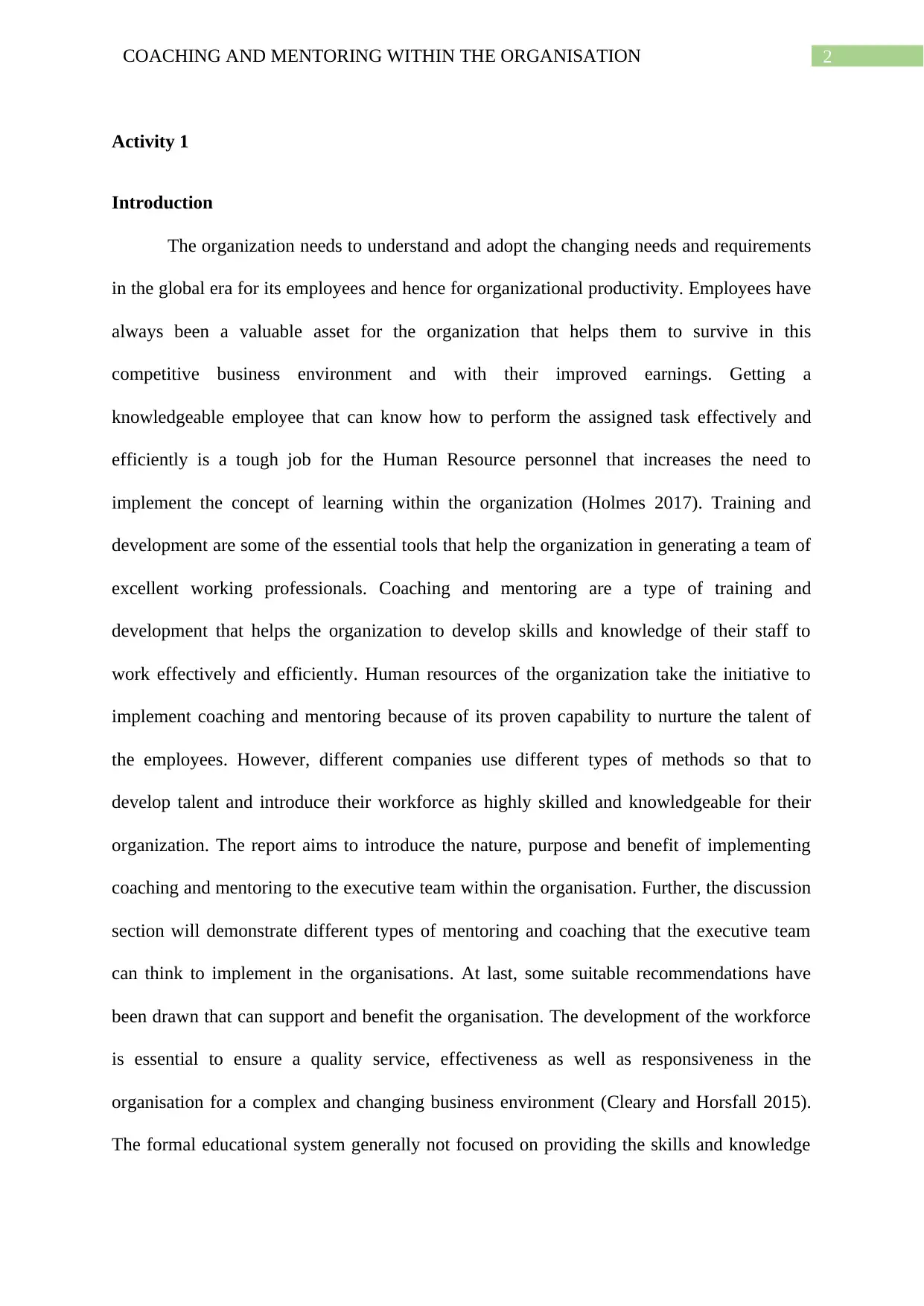
2COACHING AND MENTORING WITHIN THE ORGANISATION
Activity 1
Introduction
The organization needs to understand and adopt the changing needs and requirements
in the global era for its employees and hence for organizational productivity. Employees have
always been a valuable asset for the organization that helps them to survive in this
competitive business environment and with their improved earnings. Getting a
knowledgeable employee that can know how to perform the assigned task effectively and
efficiently is a tough job for the Human Resource personnel that increases the need to
implement the concept of learning within the organization (Holmes 2017). Training and
development are some of the essential tools that help the organization in generating a team of
excellent working professionals. Coaching and mentoring are a type of training and
development that helps the organization to develop skills and knowledge of their staff to
work effectively and efficiently. Human resources of the organization take the initiative to
implement coaching and mentoring because of its proven capability to nurture the talent of
the employees. However, different companies use different types of methods so that to
develop talent and introduce their workforce as highly skilled and knowledgeable for their
organization. The report aims to introduce the nature, purpose and benefit of implementing
coaching and mentoring to the executive team within the organisation. Further, the discussion
section will demonstrate different types of mentoring and coaching that the executive team
can think to implement in the organisations. At last, some suitable recommendations have
been drawn that can support and benefit the organisation. The development of the workforce
is essential to ensure a quality service, effectiveness as well as responsiveness in the
organisation for a complex and changing business environment (Cleary and Horsfall 2015).
The formal educational system generally not focused on providing the skills and knowledge
Activity 1
Introduction
The organization needs to understand and adopt the changing needs and requirements
in the global era for its employees and hence for organizational productivity. Employees have
always been a valuable asset for the organization that helps them to survive in this
competitive business environment and with their improved earnings. Getting a
knowledgeable employee that can know how to perform the assigned task effectively and
efficiently is a tough job for the Human Resource personnel that increases the need to
implement the concept of learning within the organization (Holmes 2017). Training and
development are some of the essential tools that help the organization in generating a team of
excellent working professionals. Coaching and mentoring are a type of training and
development that helps the organization to develop skills and knowledge of their staff to
work effectively and efficiently. Human resources of the organization take the initiative to
implement coaching and mentoring because of its proven capability to nurture the talent of
the employees. However, different companies use different types of methods so that to
develop talent and introduce their workforce as highly skilled and knowledgeable for their
organization. The report aims to introduce the nature, purpose and benefit of implementing
coaching and mentoring to the executive team within the organisation. Further, the discussion
section will demonstrate different types of mentoring and coaching that the executive team
can think to implement in the organisations. At last, some suitable recommendations have
been drawn that can support and benefit the organisation. The development of the workforce
is essential to ensure a quality service, effectiveness as well as responsiveness in the
organisation for a complex and changing business environment (Cleary and Horsfall 2015).
The formal educational system generally not focused on providing the skills and knowledge
⊘ This is a preview!⊘
Do you want full access?
Subscribe today to unlock all pages.

Trusted by 1+ million students worldwide
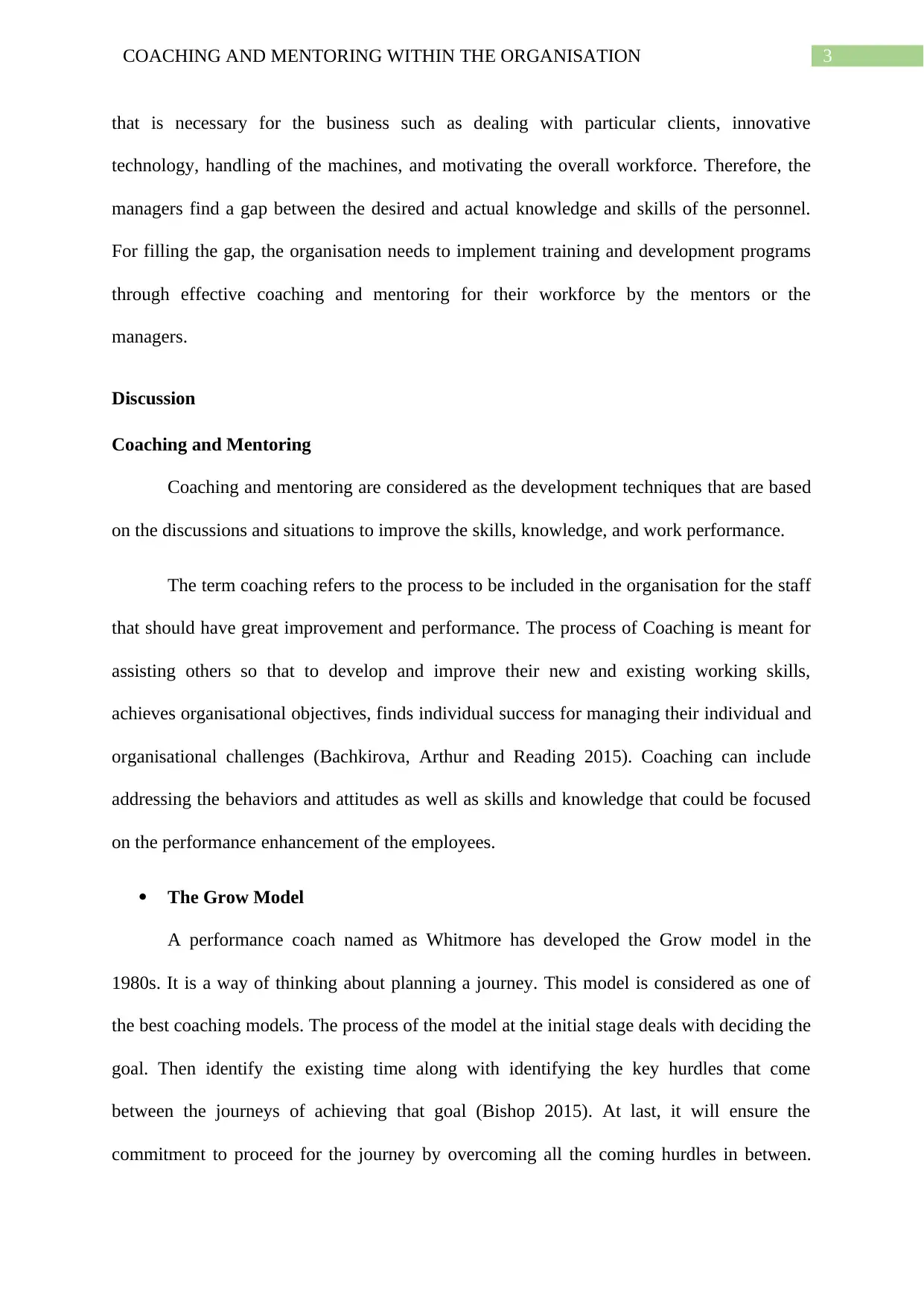
3COACHING AND MENTORING WITHIN THE ORGANISATION
that is necessary for the business such as dealing with particular clients, innovative
technology, handling of the machines, and motivating the overall workforce. Therefore, the
managers find a gap between the desired and actual knowledge and skills of the personnel.
For filling the gap, the organisation needs to implement training and development programs
through effective coaching and mentoring for their workforce by the mentors or the
managers.
Discussion
Coaching and Mentoring
Coaching and mentoring are considered as the development techniques that are based
on the discussions and situations to improve the skills, knowledge, and work performance.
The term coaching refers to the process to be included in the organisation for the staff
that should have great improvement and performance. The process of Coaching is meant for
assisting others so that to develop and improve their new and existing working skills,
achieves organisational objectives, finds individual success for managing their individual and
organisational challenges (Bachkirova, Arthur and Reading 2015). Coaching can include
addressing the behaviors and attitudes as well as skills and knowledge that could be focused
on the performance enhancement of the employees.
The Grow Model
A performance coach named as Whitmore has developed the Grow model in the
1980s. It is a way of thinking about planning a journey. This model is considered as one of
the best coaching models. The process of the model at the initial stage deals with deciding the
goal. Then identify the existing time along with identifying the key hurdles that come
between the journeys of achieving that goal (Bishop 2015). At last, it will ensure the
commitment to proceed for the journey by overcoming all the coming hurdles in between.
that is necessary for the business such as dealing with particular clients, innovative
technology, handling of the machines, and motivating the overall workforce. Therefore, the
managers find a gap between the desired and actual knowledge and skills of the personnel.
For filling the gap, the organisation needs to implement training and development programs
through effective coaching and mentoring for their workforce by the mentors or the
managers.
Discussion
Coaching and Mentoring
Coaching and mentoring are considered as the development techniques that are based
on the discussions and situations to improve the skills, knowledge, and work performance.
The term coaching refers to the process to be included in the organisation for the staff
that should have great improvement and performance. The process of Coaching is meant for
assisting others so that to develop and improve their new and existing working skills,
achieves organisational objectives, finds individual success for managing their individual and
organisational challenges (Bachkirova, Arthur and Reading 2015). Coaching can include
addressing the behaviors and attitudes as well as skills and knowledge that could be focused
on the performance enhancement of the employees.
The Grow Model
A performance coach named as Whitmore has developed the Grow model in the
1980s. It is a way of thinking about planning a journey. This model is considered as one of
the best coaching models. The process of the model at the initial stage deals with deciding the
goal. Then identify the existing time along with identifying the key hurdles that come
between the journeys of achieving that goal (Bishop 2015). At last, it will ensure the
commitment to proceed for the journey by overcoming all the coming hurdles in between.
Paraphrase This Document
Need a fresh take? Get an instant paraphrase of this document with our AI Paraphraser
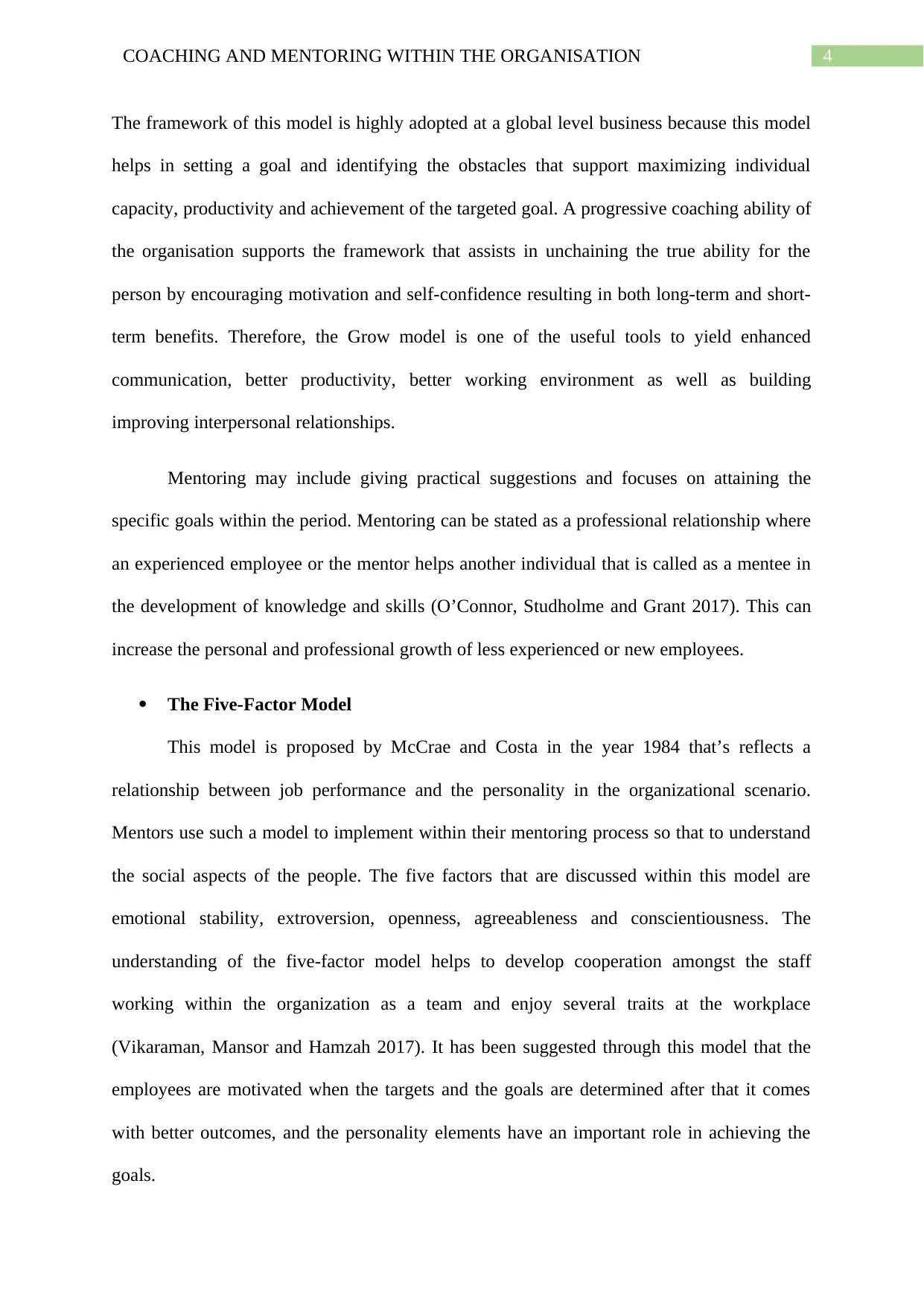
4COACHING AND MENTORING WITHIN THE ORGANISATION
The framework of this model is highly adopted at a global level business because this model
helps in setting a goal and identifying the obstacles that support maximizing individual
capacity, productivity and achievement of the targeted goal. A progressive coaching ability of
the organisation supports the framework that assists in unchaining the true ability for the
person by encouraging motivation and self-confidence resulting in both long-term and short-
term benefits. Therefore, the Grow model is one of the useful tools to yield enhanced
communication, better productivity, better working environment as well as building
improving interpersonal relationships.
Mentoring may include giving practical suggestions and focuses on attaining the
specific goals within the period. Mentoring can be stated as a professional relationship where
an experienced employee or the mentor helps another individual that is called as a mentee in
the development of knowledge and skills (O’Connor, Studholme and Grant 2017). This can
increase the personal and professional growth of less experienced or new employees.
The Five-Factor Model
This model is proposed by McCrae and Costa in the year 1984 that’s reflects a
relationship between job performance and the personality in the organizational scenario.
Mentors use such a model to implement within their mentoring process so that to understand
the social aspects of the people. The five factors that are discussed within this model are
emotional stability, extroversion, openness, agreeableness and conscientiousness. The
understanding of the five-factor model helps to develop cooperation amongst the staff
working within the organization as a team and enjoy several traits at the workplace
(Vikaraman, Mansor and Hamzah 2017). It has been suggested through this model that the
employees are motivated when the targets and the goals are determined after that it comes
with better outcomes, and the personality elements have an important role in achieving the
goals.
The framework of this model is highly adopted at a global level business because this model
helps in setting a goal and identifying the obstacles that support maximizing individual
capacity, productivity and achievement of the targeted goal. A progressive coaching ability of
the organisation supports the framework that assists in unchaining the true ability for the
person by encouraging motivation and self-confidence resulting in both long-term and short-
term benefits. Therefore, the Grow model is one of the useful tools to yield enhanced
communication, better productivity, better working environment as well as building
improving interpersonal relationships.
Mentoring may include giving practical suggestions and focuses on attaining the
specific goals within the period. Mentoring can be stated as a professional relationship where
an experienced employee or the mentor helps another individual that is called as a mentee in
the development of knowledge and skills (O’Connor, Studholme and Grant 2017). This can
increase the personal and professional growth of less experienced or new employees.
The Five-Factor Model
This model is proposed by McCrae and Costa in the year 1984 that’s reflects a
relationship between job performance and the personality in the organizational scenario.
Mentors use such a model to implement within their mentoring process so that to understand
the social aspects of the people. The five factors that are discussed within this model are
emotional stability, extroversion, openness, agreeableness and conscientiousness. The
understanding of the five-factor model helps to develop cooperation amongst the staff
working within the organization as a team and enjoy several traits at the workplace
(Vikaraman, Mansor and Hamzah 2017). It has been suggested through this model that the
employees are motivated when the targets and the goals are determined after that it comes
with better outcomes, and the personality elements have an important role in achieving the
goals.
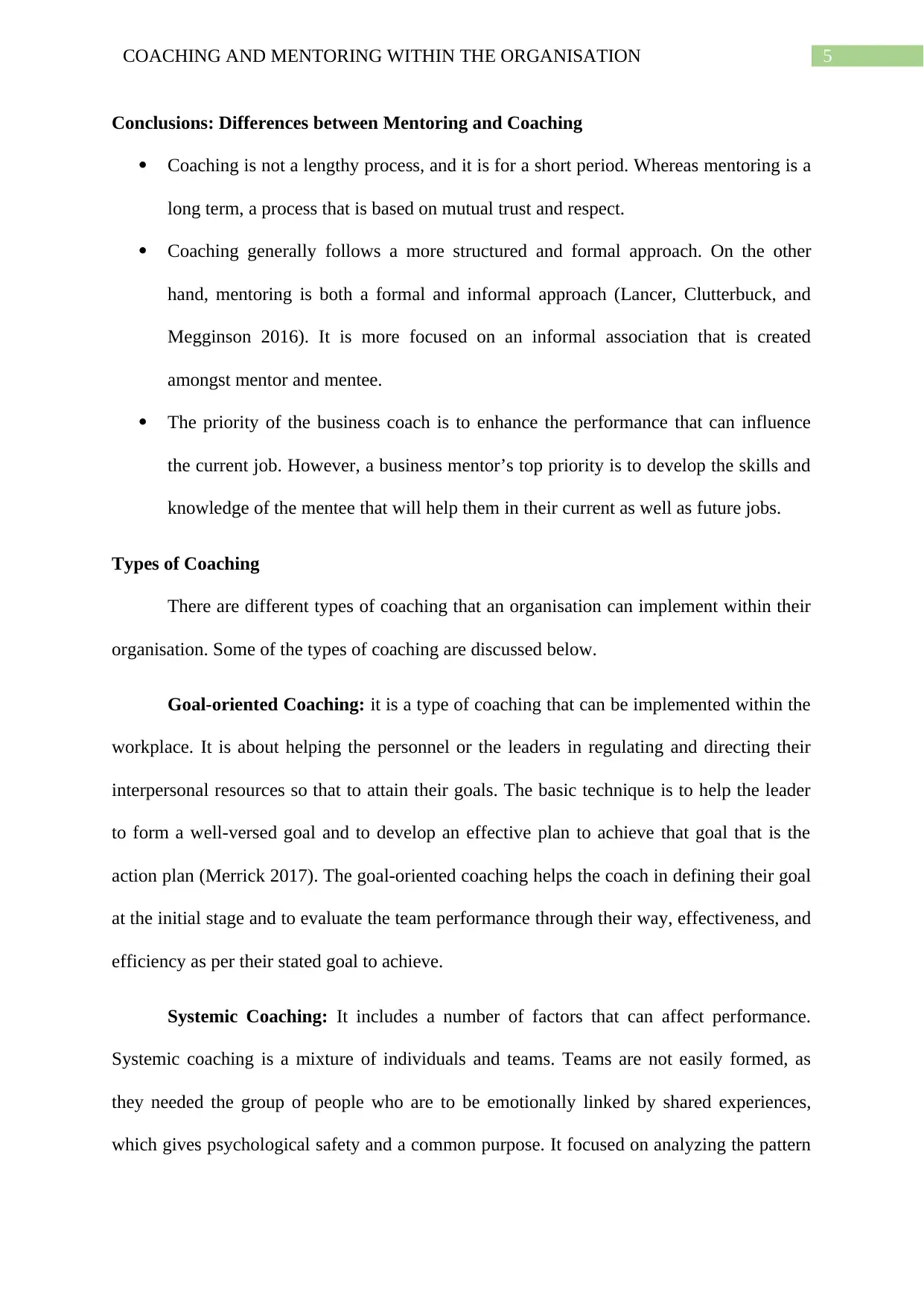
5COACHING AND MENTORING WITHIN THE ORGANISATION
Conclusions: Differences between Mentoring and Coaching
Coaching is not a lengthy process, and it is for a short period. Whereas mentoring is a
long term, a process that is based on mutual trust and respect.
Coaching generally follows a more structured and formal approach. On the other
hand, mentoring is both a formal and informal approach (Lancer, Clutterbuck, and
Megginson 2016). It is more focused on an informal association that is created
amongst mentor and mentee.
The priority of the business coach is to enhance the performance that can influence
the current job. However, a business mentor’s top priority is to develop the skills and
knowledge of the mentee that will help them in their current as well as future jobs.
Types of Coaching
There are different types of coaching that an organisation can implement within their
organisation. Some of the types of coaching are discussed below.
Goal-oriented Coaching: it is a type of coaching that can be implemented within the
workplace. It is about helping the personnel or the leaders in regulating and directing their
interpersonal resources so that to attain their goals. The basic technique is to help the leader
to form a well-versed goal and to develop an effective plan to achieve that goal that is the
action plan (Merrick 2017). The goal-oriented coaching helps the coach in defining their goal
at the initial stage and to evaluate the team performance through their way, effectiveness, and
efficiency as per their stated goal to achieve.
Systemic Coaching: It includes a number of factors that can affect performance.
Systemic coaching is a mixture of individuals and teams. Teams are not easily formed, as
they needed the group of people who are to be emotionally linked by shared experiences,
which gives psychological safety and a common purpose. It focused on analyzing the pattern
Conclusions: Differences between Mentoring and Coaching
Coaching is not a lengthy process, and it is for a short period. Whereas mentoring is a
long term, a process that is based on mutual trust and respect.
Coaching generally follows a more structured and formal approach. On the other
hand, mentoring is both a formal and informal approach (Lancer, Clutterbuck, and
Megginson 2016). It is more focused on an informal association that is created
amongst mentor and mentee.
The priority of the business coach is to enhance the performance that can influence
the current job. However, a business mentor’s top priority is to develop the skills and
knowledge of the mentee that will help them in their current as well as future jobs.
Types of Coaching
There are different types of coaching that an organisation can implement within their
organisation. Some of the types of coaching are discussed below.
Goal-oriented Coaching: it is a type of coaching that can be implemented within the
workplace. It is about helping the personnel or the leaders in regulating and directing their
interpersonal resources so that to attain their goals. The basic technique is to help the leader
to form a well-versed goal and to develop an effective plan to achieve that goal that is the
action plan (Merrick 2017). The goal-oriented coaching helps the coach in defining their goal
at the initial stage and to evaluate the team performance through their way, effectiveness, and
efficiency as per their stated goal to achieve.
Systemic Coaching: It includes a number of factors that can affect performance.
Systemic coaching is a mixture of individuals and teams. Teams are not easily formed, as
they needed the group of people who are to be emotionally linked by shared experiences,
which gives psychological safety and a common purpose. It focused on analyzing the pattern
⊘ This is a preview!⊘
Do you want full access?
Subscribe today to unlock all pages.

Trusted by 1+ million students worldwide
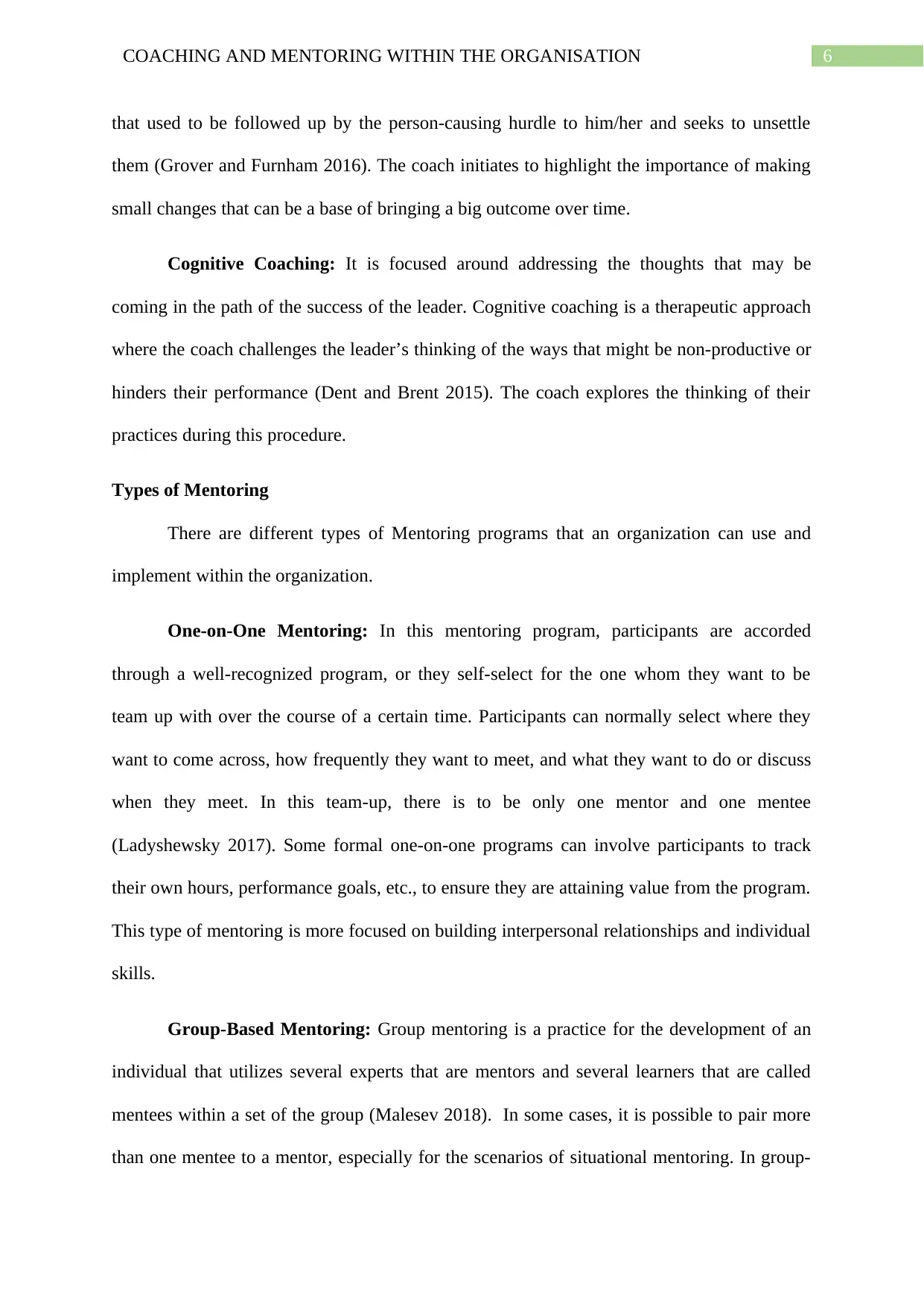
6COACHING AND MENTORING WITHIN THE ORGANISATION
that used to be followed up by the person-causing hurdle to him/her and seeks to unsettle
them (Grover and Furnham 2016). The coach initiates to highlight the importance of making
small changes that can be a base of bringing a big outcome over time.
Cognitive Coaching: It is focused around addressing the thoughts that may be
coming in the path of the success of the leader. Cognitive coaching is a therapeutic approach
where the coach challenges the leader’s thinking of the ways that might be non-productive or
hinders their performance (Dent and Brent 2015). The coach explores the thinking of their
practices during this procedure.
Types of Mentoring
There are different types of Mentoring programs that an organization can use and
implement within the organization.
One-on-One Mentoring: In this mentoring program, participants are accorded
through a well-recognized program, or they self-select for the one whom they want to be
team up with over the course of a certain time. Participants can normally select where they
want to come across, how frequently they want to meet, and what they want to do or discuss
when they meet. In this team-up, there is to be only one mentor and one mentee
(Ladyshewsky 2017). Some formal one-on-one programs can involve participants to track
their own hours, performance goals, etc., to ensure they are attaining value from the program.
This type of mentoring is more focused on building interpersonal relationships and individual
skills.
Group-Based Mentoring: Group mentoring is a practice for the development of an
individual that utilizes several experts that are mentors and several learners that are called
mentees within a set of the group (Malesev 2018). In some cases, it is possible to pair more
than one mentee to a mentor, especially for the scenarios of situational mentoring. In group-
that used to be followed up by the person-causing hurdle to him/her and seeks to unsettle
them (Grover and Furnham 2016). The coach initiates to highlight the importance of making
small changes that can be a base of bringing a big outcome over time.
Cognitive Coaching: It is focused around addressing the thoughts that may be
coming in the path of the success of the leader. Cognitive coaching is a therapeutic approach
where the coach challenges the leader’s thinking of the ways that might be non-productive or
hinders their performance (Dent and Brent 2015). The coach explores the thinking of their
practices during this procedure.
Types of Mentoring
There are different types of Mentoring programs that an organization can use and
implement within the organization.
One-on-One Mentoring: In this mentoring program, participants are accorded
through a well-recognized program, or they self-select for the one whom they want to be
team up with over the course of a certain time. Participants can normally select where they
want to come across, how frequently they want to meet, and what they want to do or discuss
when they meet. In this team-up, there is to be only one mentor and one mentee
(Ladyshewsky 2017). Some formal one-on-one programs can involve participants to track
their own hours, performance goals, etc., to ensure they are attaining value from the program.
This type of mentoring is more focused on building interpersonal relationships and individual
skills.
Group-Based Mentoring: Group mentoring is a practice for the development of an
individual that utilizes several experts that are mentors and several learners that are called
mentees within a set of the group (Malesev 2018). In some cases, it is possible to pair more
than one mentee to a mentor, especially for the scenarios of situational mentoring. In group-
Paraphrase This Document
Need a fresh take? Get an instant paraphrase of this document with our AI Paraphraser
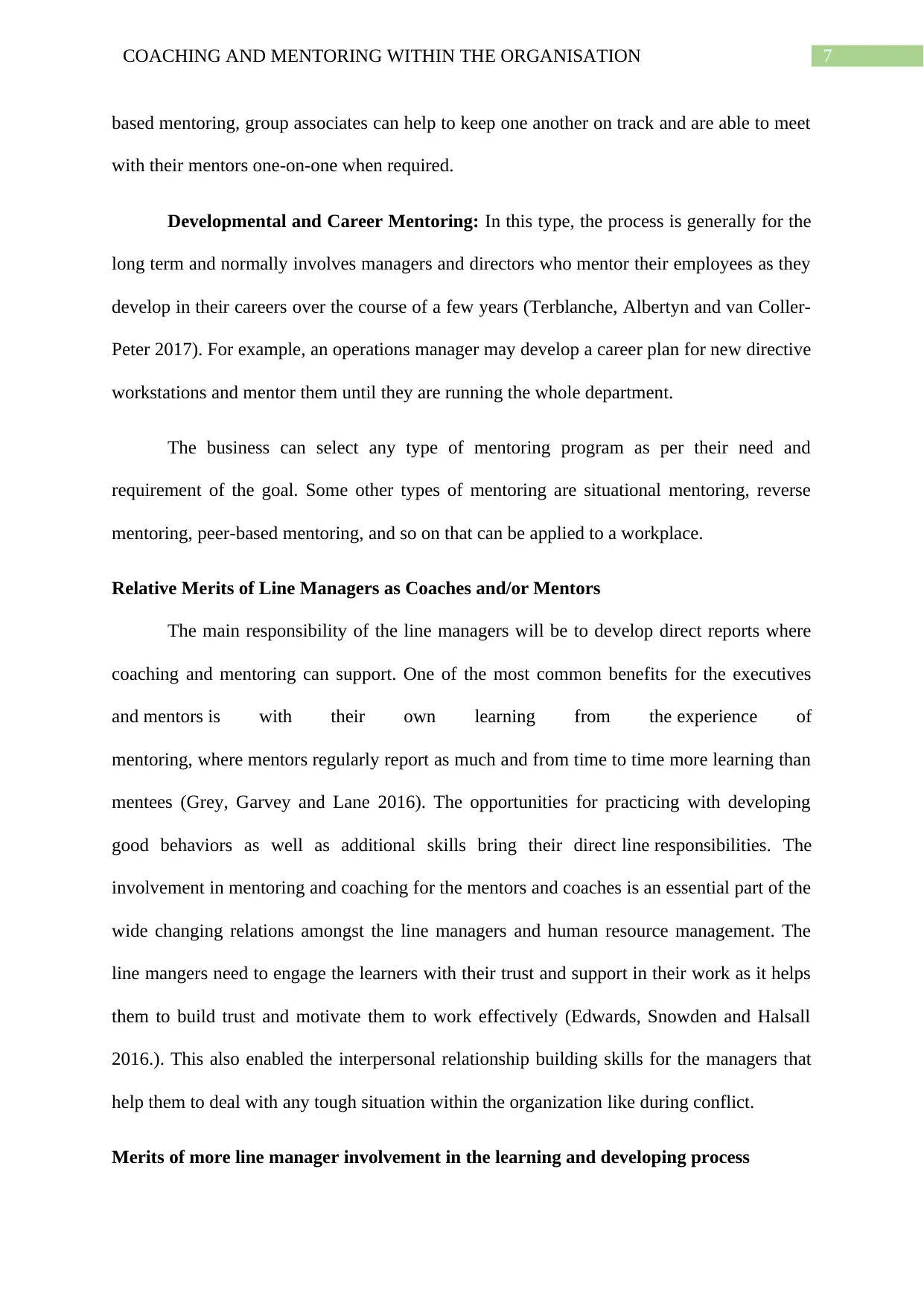
7COACHING AND MENTORING WITHIN THE ORGANISATION
based mentoring, group associates can help to keep one another on track and are able to meet
with their mentors one-on-one when required.
Developmental and Career Mentoring: In this type, the process is generally for the
long term and normally involves managers and directors who mentor their employees as they
develop in their careers over the course of a few years (Terblanche, Albertyn and van Coller-
Peter 2017). For example, an operations manager may develop a career plan for new directive
workstations and mentor them until they are running the whole department.
The business can select any type of mentoring program as per their need and
requirement of the goal. Some other types of mentoring are situational mentoring, reverse
mentoring, peer-based mentoring, and so on that can be applied to a workplace.
Relative Merits of Line Managers as Coaches and/or Mentors
The main responsibility of the line managers will be to develop direct reports where
coaching and mentoring can support. One of the most common benefits for the executives
and mentors is with their own learning from the experience of
mentoring, where mentors regularly report as much and from time to time more learning than
mentees (Grey, Garvey and Lane 2016). The opportunities for practicing with developing
good behaviors as well as additional skills bring their direct line responsibilities. The
involvement in mentoring and coaching for the mentors and coaches is an essential part of the
wide changing relations amongst the line managers and human resource management. The
line mangers need to engage the learners with their trust and support in their work as it helps
them to build trust and motivate them to work effectively (Edwards, Snowden and Halsall
2016.). This also enabled the interpersonal relationship building skills for the managers that
help them to deal with any tough situation within the organization like during conflict.
Merits of more line manager involvement in the learning and developing process
based mentoring, group associates can help to keep one another on track and are able to meet
with their mentors one-on-one when required.
Developmental and Career Mentoring: In this type, the process is generally for the
long term and normally involves managers and directors who mentor their employees as they
develop in their careers over the course of a few years (Terblanche, Albertyn and van Coller-
Peter 2017). For example, an operations manager may develop a career plan for new directive
workstations and mentor them until they are running the whole department.
The business can select any type of mentoring program as per their need and
requirement of the goal. Some other types of mentoring are situational mentoring, reverse
mentoring, peer-based mentoring, and so on that can be applied to a workplace.
Relative Merits of Line Managers as Coaches and/or Mentors
The main responsibility of the line managers will be to develop direct reports where
coaching and mentoring can support. One of the most common benefits for the executives
and mentors is with their own learning from the experience of
mentoring, where mentors regularly report as much and from time to time more learning than
mentees (Grey, Garvey and Lane 2016). The opportunities for practicing with developing
good behaviors as well as additional skills bring their direct line responsibilities. The
involvement in mentoring and coaching for the mentors and coaches is an essential part of the
wide changing relations amongst the line managers and human resource management. The
line mangers need to engage the learners with their trust and support in their work as it helps
them to build trust and motivate them to work effectively (Edwards, Snowden and Halsall
2016.). This also enabled the interpersonal relationship building skills for the managers that
help them to deal with any tough situation within the organization like during conflict.
Merits of more line manager involvement in the learning and developing process
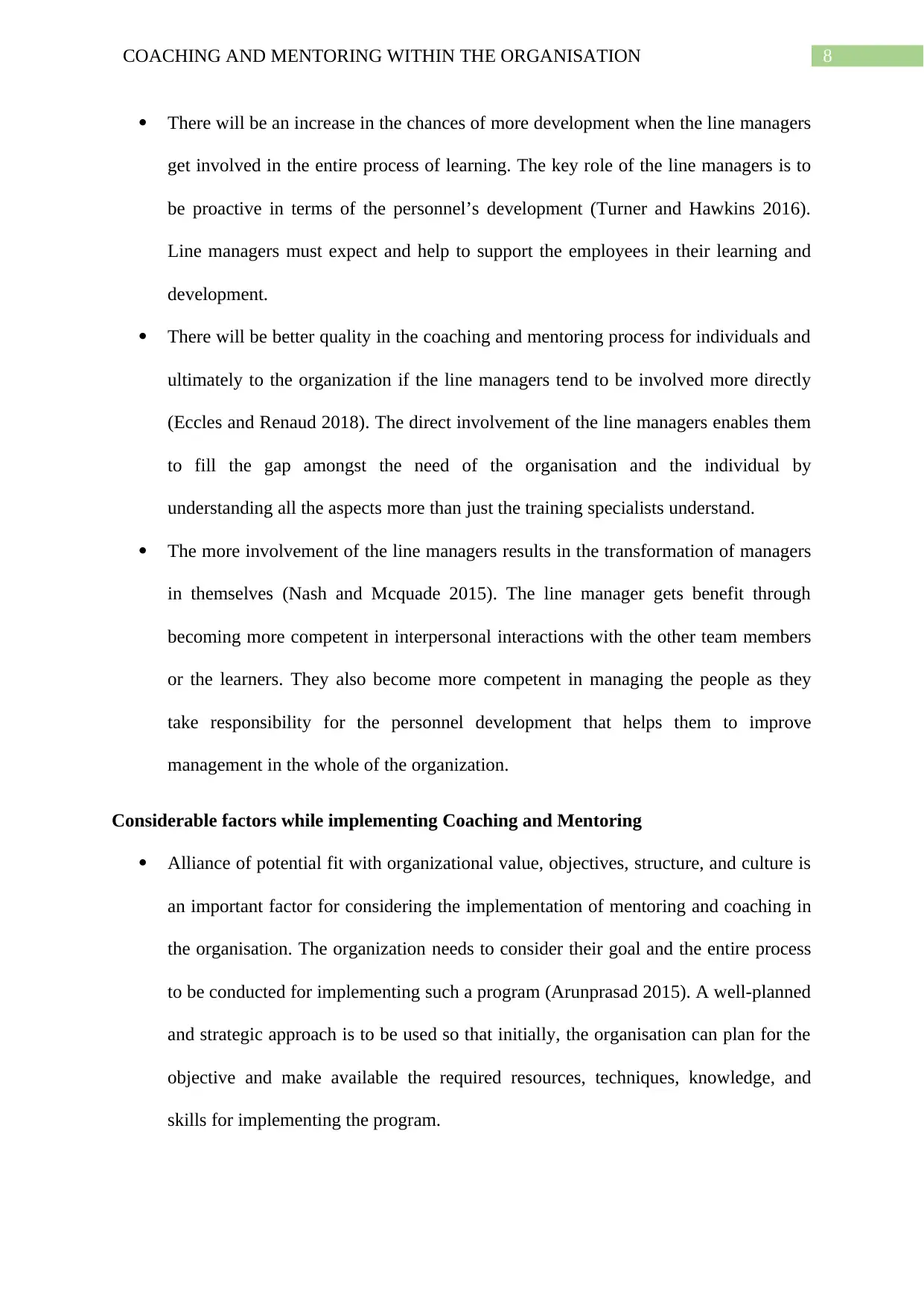
8COACHING AND MENTORING WITHIN THE ORGANISATION
There will be an increase in the chances of more development when the line managers
get involved in the entire process of learning. The key role of the line managers is to
be proactive in terms of the personnel’s development (Turner and Hawkins 2016).
Line managers must expect and help to support the employees in their learning and
development.
There will be better quality in the coaching and mentoring process for individuals and
ultimately to the organization if the line managers tend to be involved more directly
(Eccles and Renaud 2018). The direct involvement of the line managers enables them
to fill the gap amongst the need of the organisation and the individual by
understanding all the aspects more than just the training specialists understand.
The more involvement of the line managers results in the transformation of managers
in themselves (Nash and Mcquade 2015). The line manager gets benefit through
becoming more competent in interpersonal interactions with the other team members
or the learners. They also become more competent in managing the people as they
take responsibility for the personnel development that helps them to improve
management in the whole of the organization.
Considerable factors while implementing Coaching and Mentoring
Alliance of potential fit with organizational value, objectives, structure, and culture is
an important factor for considering the implementation of mentoring and coaching in
the organisation. The organization needs to consider their goal and the entire process
to be conducted for implementing such a program (Arunprasad 2015). A well-planned
and strategic approach is to be used so that initially, the organisation can plan for the
objective and make available the required resources, techniques, knowledge, and
skills for implementing the program.
There will be an increase in the chances of more development when the line managers
get involved in the entire process of learning. The key role of the line managers is to
be proactive in terms of the personnel’s development (Turner and Hawkins 2016).
Line managers must expect and help to support the employees in their learning and
development.
There will be better quality in the coaching and mentoring process for individuals and
ultimately to the organization if the line managers tend to be involved more directly
(Eccles and Renaud 2018). The direct involvement of the line managers enables them
to fill the gap amongst the need of the organisation and the individual by
understanding all the aspects more than just the training specialists understand.
The more involvement of the line managers results in the transformation of managers
in themselves (Nash and Mcquade 2015). The line manager gets benefit through
becoming more competent in interpersonal interactions with the other team members
or the learners. They also become more competent in managing the people as they
take responsibility for the personnel development that helps them to improve
management in the whole of the organization.
Considerable factors while implementing Coaching and Mentoring
Alliance of potential fit with organizational value, objectives, structure, and culture is
an important factor for considering the implementation of mentoring and coaching in
the organisation. The organization needs to consider their goal and the entire process
to be conducted for implementing such a program (Arunprasad 2015). A well-planned
and strategic approach is to be used so that initially, the organisation can plan for the
objective and make available the required resources, techniques, knowledge, and
skills for implementing the program.
⊘ This is a preview!⊘
Do you want full access?
Subscribe today to unlock all pages.

Trusted by 1+ million students worldwide
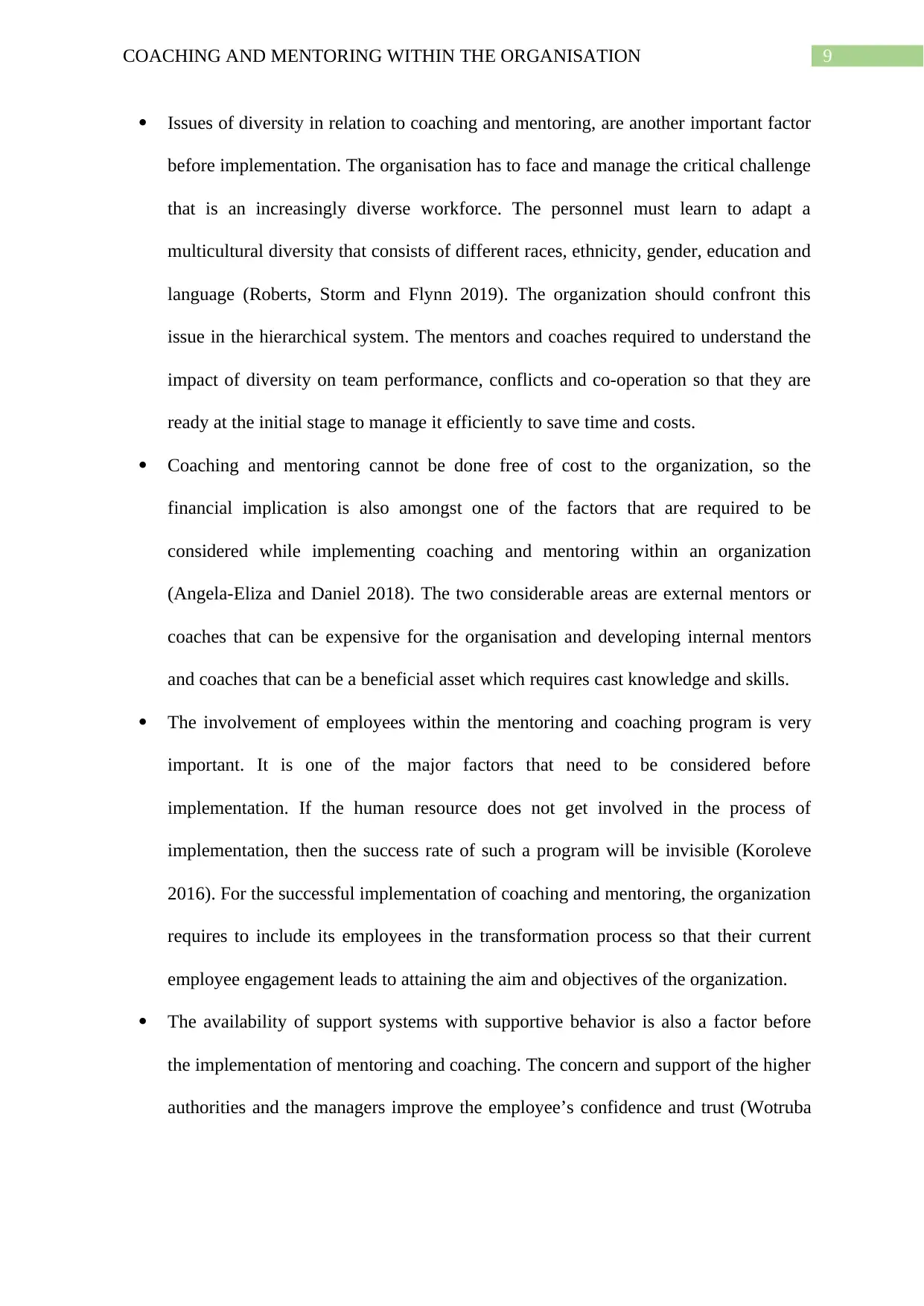
9COACHING AND MENTORING WITHIN THE ORGANISATION
Issues of diversity in relation to coaching and mentoring, are another important factor
before implementation. The organisation has to face and manage the critical challenge
that is an increasingly diverse workforce. The personnel must learn to adapt a
multicultural diversity that consists of different races, ethnicity, gender, education and
language (Roberts, Storm and Flynn 2019). The organization should confront this
issue in the hierarchical system. The mentors and coaches required to understand the
impact of diversity on team performance, conflicts and co-operation so that they are
ready at the initial stage to manage it efficiently to save time and costs.
Coaching and mentoring cannot be done free of cost to the organization, so the
financial implication is also amongst one of the factors that are required to be
considered while implementing coaching and mentoring within an organization
(Angela-Eliza and Daniel 2018). The two considerable areas are external mentors or
coaches that can be expensive for the organisation and developing internal mentors
and coaches that can be a beneficial asset which requires cast knowledge and skills.
The involvement of employees within the mentoring and coaching program is very
important. It is one of the major factors that need to be considered before
implementation. If the human resource does not get involved in the process of
implementation, then the success rate of such a program will be invisible (Koroleve
2016). For the successful implementation of coaching and mentoring, the organization
requires to include its employees in the transformation process so that their current
employee engagement leads to attaining the aim and objectives of the organization.
The availability of support systems with supportive behavior is also a factor before
the implementation of mentoring and coaching. The concern and support of the higher
authorities and the managers improve the employee’s confidence and trust (Wotruba
Issues of diversity in relation to coaching and mentoring, are another important factor
before implementation. The organisation has to face and manage the critical challenge
that is an increasingly diverse workforce. The personnel must learn to adapt a
multicultural diversity that consists of different races, ethnicity, gender, education and
language (Roberts, Storm and Flynn 2019). The organization should confront this
issue in the hierarchical system. The mentors and coaches required to understand the
impact of diversity on team performance, conflicts and co-operation so that they are
ready at the initial stage to manage it efficiently to save time and costs.
Coaching and mentoring cannot be done free of cost to the organization, so the
financial implication is also amongst one of the factors that are required to be
considered while implementing coaching and mentoring within an organization
(Angela-Eliza and Daniel 2018). The two considerable areas are external mentors or
coaches that can be expensive for the organisation and developing internal mentors
and coaches that can be a beneficial asset which requires cast knowledge and skills.
The involvement of employees within the mentoring and coaching program is very
important. It is one of the major factors that need to be considered before
implementation. If the human resource does not get involved in the process of
implementation, then the success rate of such a program will be invisible (Koroleve
2016). For the successful implementation of coaching and mentoring, the organization
requires to include its employees in the transformation process so that their current
employee engagement leads to attaining the aim and objectives of the organization.
The availability of support systems with supportive behavior is also a factor before
the implementation of mentoring and coaching. The concern and support of the higher
authorities and the managers improve the employee’s confidence and trust (Wotruba
Paraphrase This Document
Need a fresh take? Get an instant paraphrase of this document with our AI Paraphraser
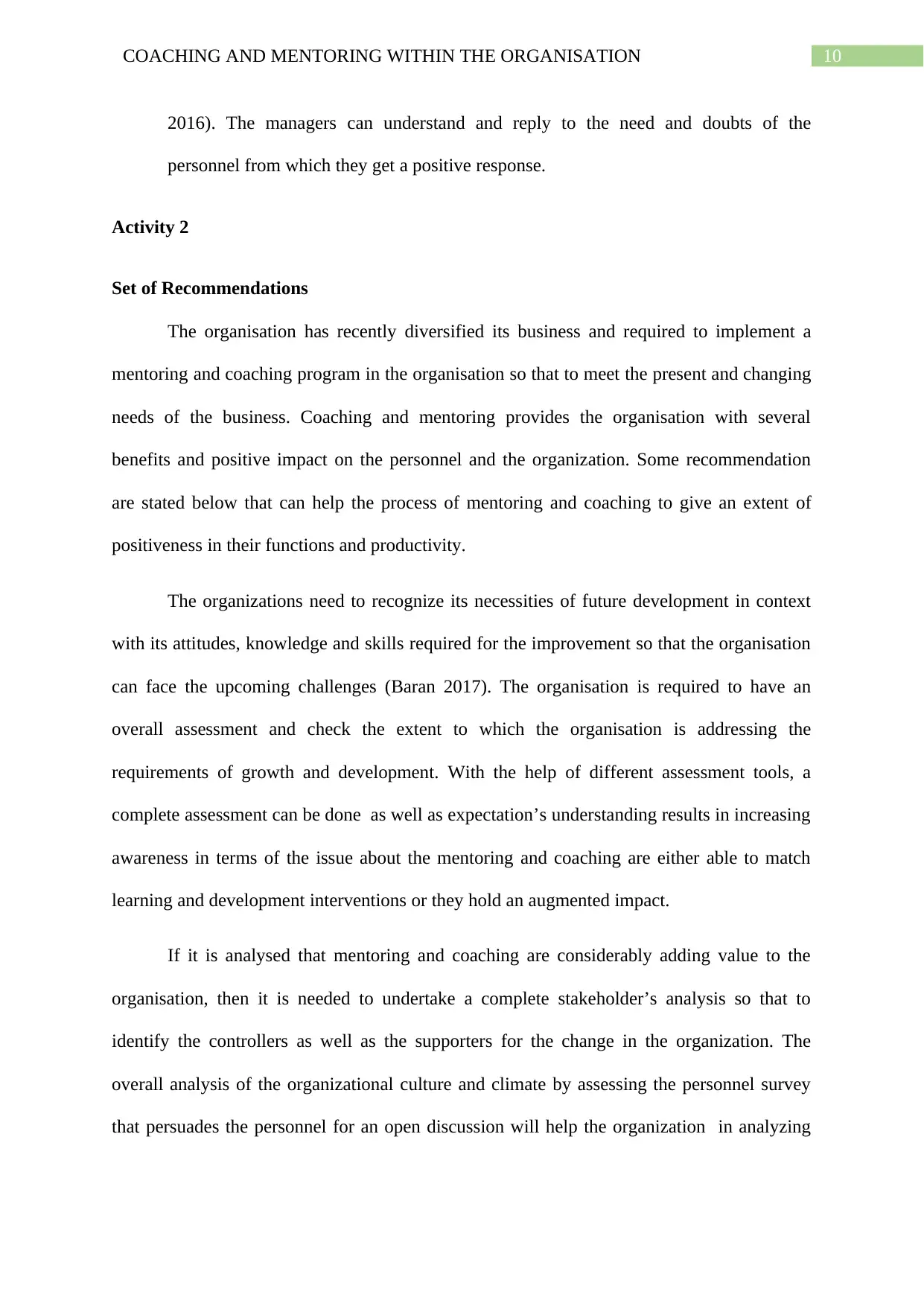
10COACHING AND MENTORING WITHIN THE ORGANISATION
2016). The managers can understand and reply to the need and doubts of the
personnel from which they get a positive response.
Activity 2
Set of Recommendations
The organisation has recently diversified its business and required to implement a
mentoring and coaching program in the organisation so that to meet the present and changing
needs of the business. Coaching and mentoring provides the organisation with several
benefits and positive impact on the personnel and the organization. Some recommendation
are stated below that can help the process of mentoring and coaching to give an extent of
positiveness in their functions and productivity.
The organizations need to recognize its necessities of future development in context
with its attitudes, knowledge and skills required for the improvement so that the organisation
can face the upcoming challenges (Baran 2017). The organisation is required to have an
overall assessment and check the extent to which the organisation is addressing the
requirements of growth and development. With the help of different assessment tools, a
complete assessment can be done as well as expectation’s understanding results in increasing
awareness in terms of the issue about the mentoring and coaching are either able to match
learning and development interventions or they hold an augmented impact.
If it is analysed that mentoring and coaching are considerably adding value to the
organisation, then it is needed to undertake a complete stakeholder’s analysis so that to
identify the controllers as well as the supporters for the change in the organization. The
overall analysis of the organizational culture and climate by assessing the personnel survey
that persuades the personnel for an open discussion will help the organization in analyzing
2016). The managers can understand and reply to the need and doubts of the
personnel from which they get a positive response.
Activity 2
Set of Recommendations
The organisation has recently diversified its business and required to implement a
mentoring and coaching program in the organisation so that to meet the present and changing
needs of the business. Coaching and mentoring provides the organisation with several
benefits and positive impact on the personnel and the organization. Some recommendation
are stated below that can help the process of mentoring and coaching to give an extent of
positiveness in their functions and productivity.
The organizations need to recognize its necessities of future development in context
with its attitudes, knowledge and skills required for the improvement so that the organisation
can face the upcoming challenges (Baran 2017). The organisation is required to have an
overall assessment and check the extent to which the organisation is addressing the
requirements of growth and development. With the help of different assessment tools, a
complete assessment can be done as well as expectation’s understanding results in increasing
awareness in terms of the issue about the mentoring and coaching are either able to match
learning and development interventions or they hold an augmented impact.
If it is analysed that mentoring and coaching are considerably adding value to the
organisation, then it is needed to undertake a complete stakeholder’s analysis so that to
identify the controllers as well as the supporters for the change in the organization. The
overall analysis of the organizational culture and climate by assessing the personnel survey
that persuades the personnel for an open discussion will help the organization in analyzing
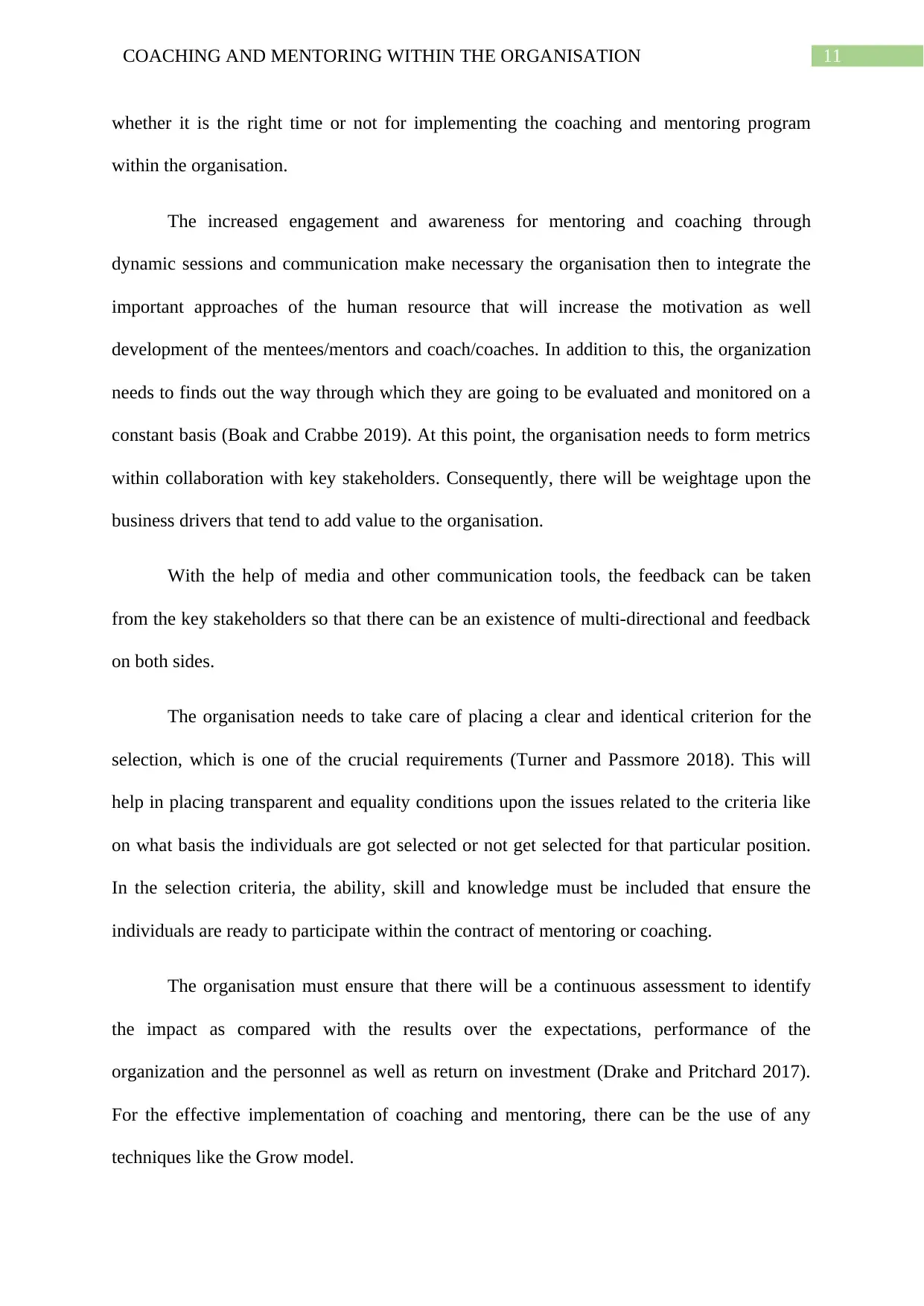
11COACHING AND MENTORING WITHIN THE ORGANISATION
whether it is the right time or not for implementing the coaching and mentoring program
within the organisation.
The increased engagement and awareness for mentoring and coaching through
dynamic sessions and communication make necessary the organisation then to integrate the
important approaches of the human resource that will increase the motivation as well
development of the mentees/mentors and coach/coaches. In addition to this, the organization
needs to finds out the way through which they are going to be evaluated and monitored on a
constant basis (Boak and Crabbe 2019). At this point, the organisation needs to form metrics
within collaboration with key stakeholders. Consequently, there will be weightage upon the
business drivers that tend to add value to the organisation.
With the help of media and other communication tools, the feedback can be taken
from the key stakeholders so that there can be an existence of multi-directional and feedback
on both sides.
The organisation needs to take care of placing a clear and identical criterion for the
selection, which is one of the crucial requirements (Turner and Passmore 2018). This will
help in placing transparent and equality conditions upon the issues related to the criteria like
on what basis the individuals are got selected or not get selected for that particular position.
In the selection criteria, the ability, skill and knowledge must be included that ensure the
individuals are ready to participate within the contract of mentoring or coaching.
The organisation must ensure that there will be a continuous assessment to identify
the impact as compared with the results over the expectations, performance of the
organization and the personnel as well as return on investment (Drake and Pritchard 2017).
For the effective implementation of coaching and mentoring, there can be the use of any
techniques like the Grow model.
whether it is the right time or not for implementing the coaching and mentoring program
within the organisation.
The increased engagement and awareness for mentoring and coaching through
dynamic sessions and communication make necessary the organisation then to integrate the
important approaches of the human resource that will increase the motivation as well
development of the mentees/mentors and coach/coaches. In addition to this, the organization
needs to finds out the way through which they are going to be evaluated and monitored on a
constant basis (Boak and Crabbe 2019). At this point, the organisation needs to form metrics
within collaboration with key stakeholders. Consequently, there will be weightage upon the
business drivers that tend to add value to the organisation.
With the help of media and other communication tools, the feedback can be taken
from the key stakeholders so that there can be an existence of multi-directional and feedback
on both sides.
The organisation needs to take care of placing a clear and identical criterion for the
selection, which is one of the crucial requirements (Turner and Passmore 2018). This will
help in placing transparent and equality conditions upon the issues related to the criteria like
on what basis the individuals are got selected or not get selected for that particular position.
In the selection criteria, the ability, skill and knowledge must be included that ensure the
individuals are ready to participate within the contract of mentoring or coaching.
The organisation must ensure that there will be a continuous assessment to identify
the impact as compared with the results over the expectations, performance of the
organization and the personnel as well as return on investment (Drake and Pritchard 2017).
For the effective implementation of coaching and mentoring, there can be the use of any
techniques like the Grow model.
⊘ This is a preview!⊘
Do you want full access?
Subscribe today to unlock all pages.

Trusted by 1+ million students worldwide
1 out of 19
Related Documents
Your All-in-One AI-Powered Toolkit for Academic Success.
+13062052269
info@desklib.com
Available 24*7 on WhatsApp / Email
![[object Object]](/_next/static/media/star-bottom.7253800d.svg)
Unlock your academic potential
Copyright © 2020–2025 A2Z Services. All Rights Reserved. Developed and managed by ZUCOL.




